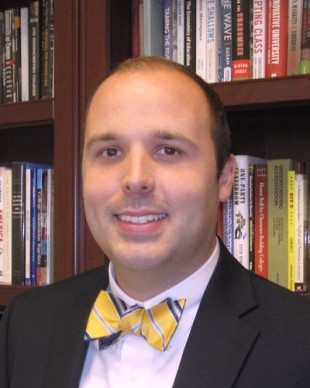Publisher's note: The John William Pope Center for Education Policy provides a treasure trove of information suggesting the better path forward in regards to North Carolina's number one issue - public education. Public education, at all levels, requires a significant amount of funding from our state government, and all one hundred North Carolina counties, so it is essential that leaders effecting education policy get it right, and know that concerned entities, like the John William Pope Center, will be minding their progress to do so. We welcome the John William Pope Center for Education Policy to our growing readership, and expect our readers to learn all they can to do their part in this wise endeavor to better educate our People.
The author of this post is Jesse Saffron.
Some colleges need to re-evaluate their financials if they want to remain viable in the long run.
Jesse Saffron, associate editor for the John William Pope Center.
In a
2009 Pope Center article, Professor Robert Blumenthal poses several questions to parents and prospective college students: "Does the institution [you're considering] have sufficient financial resources to deliver the education it promises? Does it have sufficient operating funds to provide essential academic support services and meaningful student life activities? Is there a chance that the school won't be around in 10 years?"
Professor Blumenthal's concerns about the financials of American higher education institutions may have been prophetic. In 2012, global consulting firm Bain and Company, along with the private-equity firm Sterling Partners, produced a comprehensive report on the balance sheets of approximately 1,700 colleges. They concluded that one-third of all colleges and universities are on an "unsustainable financial path."
This year, Moody's Investors Service gave the entire sector a gloomy forecast, proclaiming it is at a "critical juncture." Both the Bain/Sterling and Moody's reports pinpointed similar problems. For many colleges, revenues and endowments are down, state/federal funding is no longer automatic, and debt-based financing is up. Furthermore, tuition price sensitivity is more pronounced, as students and parents are more selective about schools and majors, wanting to get the most bang for each precious buck.
Most recently, an Inside Higher Ed/Gallup survey of campus chief financial officers painted an equally grim picture. Only 27 percent of the surveyed CFOs voiced "strong confidence" in the short-term outlook for their business models - with the percentage dropping to 13 percent when they were asked about their 10-year prospectus. The CFOs agreed in large part that non-flagship universities, for-profits and non-elite private colleges are the most vulnerable institutions. Only flagships and elite schools have a reprieve from the overall dreariness.
Does this mean that a spate of school closings is on the horizon? College closings and mergers have been a standard feature of higher education for more than 100 years. In a "normal" year, a handful (or two) of colleges close or merge, but the numbers are never large enough to stir alarm. But Department of Education figures show that 17 degree-granting schools closed in 2009-10, after reaching 26 in 2007-08. And the possibility of lower enrollment - due to the Great Recession, high tuition, and talk of a college loan "bubble" - has prompted some institutional watchdogs to hit the panic switch and predict disaster.
"In fifty years, if not much sooner, half of the roughly 4,500 colleges and universities now operating in the United States will have ceased to exist," predicted Nathan Harden in
The American Interest's January/February 2013 issue. Clayton Christensen, a prominent professor at Harvard Business School, said in a recent
interview with The Economist, "[The] vast majority of traditional universities...have no wiggle room. So I'd be very surprised if in ten years we don't see hundreds of universities in bankruptcy."
Some of the most endangered institutions - those with the least "wiggle room" - appear to be historically black colleges and universities (HBCUs), which have struggled to keep enrollment up while their traditional student population is wooed by colleges across the country.
The 125-year old St. Paul's College, a private, historically black college in southern Virginia, closed its doors in June after years of financial stress and academic deterioration led to the loss of its accreditation. After a botched merger deal that would have seen St. Augustine's College - located in Raleigh - absorb the college, St. Paul's was out of options. Earlier this month, Atlanta-based Morris Brown College, another historically black institution, filed for federal bankruptcy protection to avoid foreclosure following years of debt accumulation. And even the stability of Howard University, among the most prominent HBCUs, has been called into question. In April, a trustee wrote a public letter, warning "Howard will not be here in three years if we don't make some crucial decisions now."
According to some HBCUs, matters were complicated by a 2011 heightening of underwriting standards for Parent PLUS loans, which allegedly caused a $150 million tuition revenue shortfall for such institutions. After intensive lobbying and pressure from HBCUs, students, parents and politicians, the Department of Education recently announced that the tighter standards will be relaxed.
Another financial bellwether is the condition of for-profit colleges, until recently the fastest growing segment of the higher education business. They thrived for years by bringing higher education to new markets and pricing themselves between public and private universities. Now they have taken a major hit. For-profit universities have scrambled to cope with an almost 7 percent decline in enrollment over the last couple of years, which is a rate roughly 3 times the percentage of overall higher education declines, according to the National Student Clearinghouse.
For-profits have also faced increased pressure from federal and state governments and "consumer advocates" regarding recruitment policies and academic quality. A recent New York state probe of Career Education Corporation will force Career Education to pay $9.25 million in restitution to students, along with a $1 million penalty. And, for the next three years, the corporation must pay an independent company to verify job placement rates, something other public and private non-profit schools aren't forced to do. Highly public scrutiny of for-profits may have contributed to the sector's enrollment declines.
In a recent
Wall Street Journal interview, Richard Vedder, an economist and higher education expert, said that, despite "reaching the exact audience that Obama wants to reach"--low-income minorities - "the administration has been beating up on [for-profits] pretty hard for the past two to three years."
In spite of this increased scrutiny and a generally gloomy economic outlook, for-profits have shown remarkable adaptability. For example, the University of Phoenix eliminated 800 jobs two years ago, and announced 700 more lay-offs in the coming months and years as it closes more than half of its 227 nationwide campuses and learning centers. Career Education Corporation plans to close one-fourth of its 90 campuses and cut 900 positions. "One thing about the for-profits is that they are laser-like devoted to instruction," said Mr. Vedder, implying that, unlike some public and private non-profits, for-profit colleges don't have to deal with expansive administrative bureaucracies.
To determine whether - or how many - colleges will be in trouble, perhaps the most valuable resource is a study published by Forbes in July, "College Financial Grades." This report analyzes the financials of 925 private not-for-profits, schools ranging from Harvard University to Gardner-Webb University, reporting that 544 schools received grades in the "C" or "D" range, 253 earned a "B," and only 128 schools were given an "A."
The methodology employed by Forbes to create this report focused on nine components.
One was the primary reserve ratio, which shows how long a college can keep the doors open if forced to sell assets. Another emphasized "core revenues" - if an institution is heavily tuition dependent, it faces serious risk. The study also honed in on schools' grants and discount rates. Schools that rely extensively on discount rates to attract students face "big enrollment challenges," says Forbes. The study also analyzed institutions' endowments, operating profit margins, returns on assets, instruction expenses (the higher the percentage spent on students, the better), admission yields and asset-to-debt ratios.
With almost 60 percent of private colleges receiving a "C" or "D" grade, the bold predictions of the Hardens and Christensens of the world seem a lot less extreme, and more like sober assessments.
It is impossible to deny that higher education institutions, whether public, private or for-profit, are beset by a perfect storm of economic troubles. The number of high school graduates has dropped by 6.25 percent since the 2011 peak of 3.4 million, and a recent study funded by the College Board and ACT suggests that this graduation lull will remain until 2020. Combined with household income declines, worries about the student loan "bubble," and the emergence of online education, institutions at all levels are facing new challenges that will forever affect the collegiate landscape.
For years, colleges were motivated to expand without really focusing on efficiency, or determining which programs and departments were profitable, and which were expendable. The cascade of recent reports - from Moody's, Bain/Sterling, Inside Higher Ed, and Forbes - suggests that an institution maintaining the status quo will not be a viable long-term institution.
In sum, the evidence points to massive, but positive, disruption in higher education. Unless more colleges start planning for the future, rather than relying on old habits, your or your child's preferred school might be bankrupt before the educational revolution really gets going.























